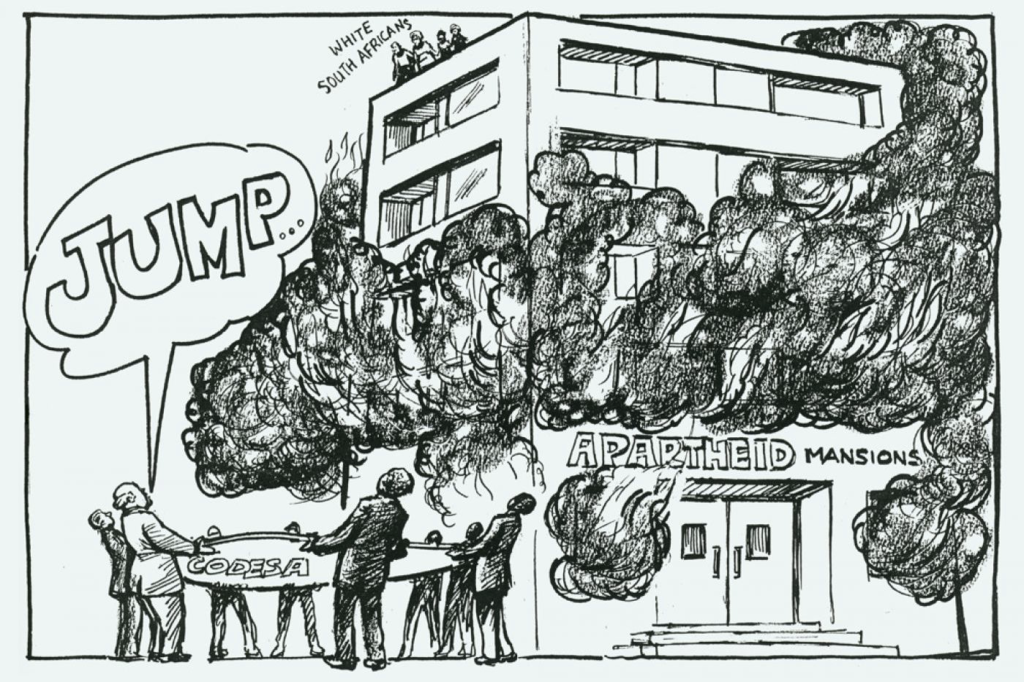Let’s took at some of the interesting political cartoons related to Apartheid movement and the life of Nelson Mandela, published between the year 1990 to 1994.
Apartheid Laws:

A caricature published in New Chronicle on 12 June 1964 was the first caricature of Nelson Mandela. The cartoon depicts how arrest of Mandela was an event to signify the arrest of the idea of justice itself. On 5th August 1962, Mandela was arrested and sent to Johannesburg’s Marshall Square prison.
There is almost no political cartoons related to life of Mandela before he was released on 11 February 1990 after 27 years of imprisonment. Censor on press in South Africa prohibited publication of any image or caricature of anti-apartheid activists.

Release of Mandela along with lifting of a 30 year ban on the African National Congress (ANC) (a pan African organisation) and other anti-apartheid organisation was depicted in cartoon as the sole hard work and commitment of president FW de Klerk’s initiative to open the South African Parliament.

Counter Violence:
After the release from prison, Mandela travelled across the world and met political leaders across the continent for support against apartheid laws. Cartoons published in south Africa on the other hand began to caricature the internal disputes and violence among the leaders and organisations involved in anti-apartheid movement.

One such cartoon is where two most powerful leaders of anti-apartheid movement Mandela and Chief Mangosuthu Buthelezi were shown on a negotiating table which was about to collapse.

The increasing violence and massacres in SA was depicted as a result of internal dispute among different anti-apartheid organisations which later successfully contested collectively by locals and leaders of anti-apartheid organisations. Another cartoon depicts suspicious role of South Africa Police in these violence. While the ways in which violent militant organisations were depicted does not appear violent but rather just discriminatory.

इसे भी पढ़ें: महात्मा की हत्या कार्टूनों की ज़ुबानी: गांधी विशेष

By August, with persistent efforts of Mandela for peaceful negotiation began to appear in cartoons. One such cartoon in which Mandela was seen putting a flower in the barrel of a gun show how media gradually began to recognise the principle of non-violence and love in Mandela’s approach towards his fight for justice.

While negotiation among different political factions involved in anti-apartheid movement reached substantial success, dispute between Mandela and president FW de Klerk continued.

However very few leaders accept their faults and Mandela was one. One of the cartoon shows Mandela admitting violence committed by members from his organisation.

Building the Nation:

The dispute over opening up the South African economy for free market was contested by Nelson Mandela. International community wanted Mandela to open South African economy for private business while Mandela was more concerned about the rights of working poor.

All political factions within south Africa agreed to come together for the formation of Democratic South Africa but maintaining coordination among them was tough task especially when people’s expectations were very high from them. The assassins were all out to hunt political leaders involved in negotiations.

The coloured south African leaders across the party line tried to ensure safety and equal treatments for whites in South Africa. Looking at two cartoons from December 1990 and September 1993 comparatively explains how white president of SA and Mandela came together.

Sporting the Nation:

Sports played important role in anti-apartheid movement. Countries across the glob boycotted South African sports team until and unless they end the apartheid. Mandela took special interest in promoting sports among native African.

The two most important achievement for democratic movement in SA were autonomous election commission and free press. But everything was not fine in SA. Several regional native community leaders refused to participate in the new democratic processes. Violence by fringe elements continued while corruption risen in the country.

Though Apartheid ended in 1993 the common masses in SA were still confused even a year later, about what actually they have achieved. community and global community. They were not able to relate with the success of South Africa and their everyday miseries.
इसे भी पढ़ें: चित्रों में कहानी-8: अम्बेडकर के जीवन से 20 ऐतिहासिक कार्टून

Credits: Most of the cartoons were published in South African daily newspaper named Sowetan and available at https://www.nelsonmandela.org

Hunt The Haunted के WhatsApp Group से जुड़ने के लिए यहाँ क्लिक करें (लिंक)
Hunt The Haunted के Facebook पेज से जुड़ने के लिए यहाँ क्लिक करें (लिंक)


